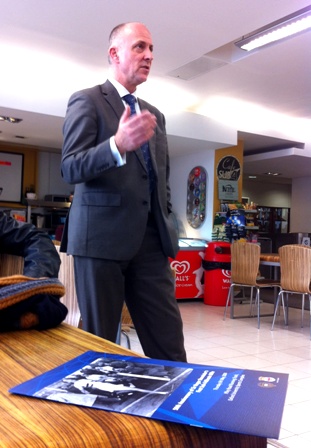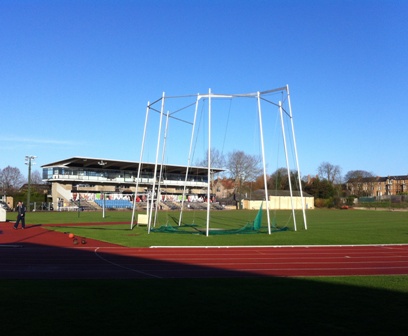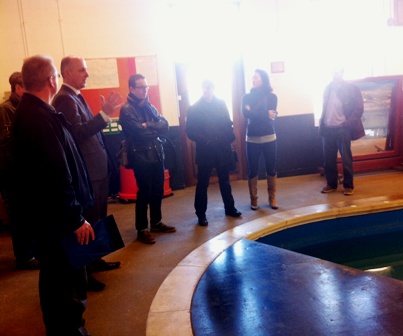
John Roycroft: at the helm of Oxford University Sport
Home of the blues: behind the scenes at Oxford University Sport
Delegates to the Leisure Review’s determinedly informal winter conference visited Iffley Road, the celebrated home of Oxford University Sport, to meet the university’s director of sport and discover the role that sport plays in Oxford life.

John Roycroft: at the helm of Oxford University Sport
From the casual observer’s perspective sport might seem to be a pursuit central to the life of the University of Oxford. It certainly has a high profile. The Boat Race, the various Varsity matches, Iffley Road, the celebrated site of the first sub-four-minute mile, and the Parks, still one of the UK’s most picturesque first-class cricket grounds, have secured national and international recognition and prestige for Oxford University sport. Visitors to the city cannot help but notice the numerous college sports grounds or the regular processions of track-suited enthusiasm heading down to the river. On summer afternoons or at any time during Eights week the whole city might seem to have been appropriated for sporting pursuits.
However, while Oxford University sport enjoys a high profile, it seems that it is not quite as central to university life as one might assume. In fact, as Jon Roycroft, the University of Oxford’s director of sport, explained, for many within the university sport is something of an irrelevance, perhaps even an encumbrance.
Roycroft welcomed the Leisure Review to the home of Oxford University Sport on one of the winter’s shortest but brightest days and, with an insight to his role, the role of sport within Oxford University and the facilities at Iffley Road as his brief, he took the scale of the university’s sports offer as his starting point. The university comprises 21,000 students, 12,000 staff and 120 nationalities, and Oxford University Sport is charged with meeting their sporting expectations. It does this with the assistance of the central facilities at Iffley Road, 15 college sports grounds, a newly acquired women’s sports ground and some 85 sports clubs.
Roycroft and his staff have calculated that 87 sports are played at Oxford. “We think more sports are played here than at any other university in the world,” he said. However, this does not necessarily equate to sport being a recognised part of the academic life of Oxford University. Indeed the popular assumption that sporting prowess might open doors is firmly refuted.
“Sport is an important part of the offer but the university has no sports courses and sport has no impact on applications at Oxford,” Roycroft explained. “Most universities need sport but at Oxford sport is not on anyone’s academic agenda. It is not part of the academic core.” In fact some high-level performers may even have been encouraged to downplay their sporting interests at interview to dissuade admissions tutors from concluding that a commitment to sport might interfere with academic studies.
Sport’s important yet peripheral place in university life creates some interesting challenges for the university’s sports department. By 1966 the university had accepted the need for some central sports facilities to supplement those provided by individual colleges and a sports hall, along with a few accompanying indoor facilities, was built. This single sport hall has remained the university’s only indoor sports facility ever since and was only joined by a swimming pool in 2004 because of a significant donation by an American graduate, Lief Rosenblatt, after whom the pool is named.
When Roycroft arrived in 1996 as the university’s first director of sport he quickly understood that some significant changes were required. Staffing issues were addressed, gym space was created and some fences were installed so that some basic access control could be implemented. As he settled in, effort was put into fundraising, which eventually led to the construction of the hockey pitch and the pool. Roycroft explained that his remit includes the college sports grounds, one of which, formerly St Catherine’s sports ground, has now become the university’s women’s sports ground. These new pitch facilities have laid to rest the long-term anomaly of female students representing the university having to pay for the privilege.
Perhaps one of the most significant initiatives was to bring the student sports federation within the structure of Oxford University Sport. Where each of the 85 university sports clubs had been separate entities managed independently by the elected officers of each club, Oxford University Sport now offers extensive assistance to these club officers.
“The role of director of sport is responsible for compliance of all the sports clubs,” Roycroft said. “We are the enablers of this process. We recognise that the academic demands on students are very high, certainly much higher than they used to be, so we try to provide service to clubs and student officers. The department also fulfils a health and safety remit for all clubs, providing a dedicated member of staff to ensure all clubs are compliant with the university’s own requirements and those of the relevant national governing bodies.”
While working with sports clubs is one reflection of how university sport has evolved over recent years, the tradition of students wanting to take the opportunity of university to get involved with new sports and new activities remains strong. However, with only one sports hall available, Oxford University Sport is under great pressure to meet these expectations and Roycroft offered volleyball as a pertinent example. At the start of an academic year some 120 people turned up for the women’s volleyball team trials but with the university having space to run only one team this meant that as few as five places were available. As a result 115 people keen to play volleyball walked away from the trial event with nowhere to go to continue their involvement with the sport. This, of course, is a real cause for concern for the club, for Roycroft and for anyone with an understanding of how difficult it can be to create and sustain engagement with participation.
Roycroft is able to report that women’s sport has seen significant growth at Oxford, particularly in the traditional college sports such as rugby and football. Along with the general growth in the health and fitness demand, this has exacerbated pressure on the university’s central facilities and Roycroft is confident that the 2014 women’s Boat Race, which for the first time is being run on the Tideway on the same day as the men’s race, will increase demand in one of Oxford’s most popular sports.
But a solution to rising demand for facilities proves to be at hand as, with a practised flourish, Roycroft reveals the boards that display the masterplan for a major development of the Iffley Road site. Under the scheme, drawn up by architects FaulknerBrowns, the pool and athletics track will be retained with extensive expansion of indoor facilities around them. The only slight problem is that the bottom line for the project is around £40 million. Phase one of the project, which will comprise a new sports hall and changing facilities, requires £6 million, half of which has been raised to date. The grand total is, Roycroft admitted, a daunting figure but is perhaps not so outlandish within the context of Oxford University’s income, which in 2011/12 totalled £1,016 million; the university’s annual report also reveals that the colleges have an aggregate endowment of more than £2.9 billion.
Meanwhile, the activity of the department continues. Roycroft is pleased by the success of women’s sport and reports of numerous teams around the country founded by female graduates on the strength of their experience of university sport at Oxford. The percentage of women continuing to play football, rugby and cricket after they leave is notably higher than those who continue rowing, although participation in rowing, an essential part of the Oxford experience, outstrips all other sports. Oxford University Sport works closely with its neighbour Oxford Brookes University and has strong contacts with the local communities; later in the Leisure Review conference programme Ian Brooke, head of leisure with Oxford city council, spoke warmly of Roycroft as one of the city’s most enthusiastic partners.
Asked about his ongoing management issues, Roycroft pondered for a moment before beginning a list that would be familiar to the many leisure management professionals: continue to keep staff turnover levels low, meet budget targets, build and extend partnerships... The list continued as he ran out of fingers but the redevelopment of the Iffley Road site is an obvious priority. While he remains hopeful that the capital outlay can be found, he is certain that he can demonstrate the demand to justify the investment.
The Leisure Review, February 2014
© Copyright of all material on this site is retained by The Leisure Review or the individual contributors where stated. Contact The Leisure Review for details.
![]() Download a pdf version of this article for printing
Download a pdf version of this article for printing

In the footsteps of Roger Bannister: the Iffley Road althletics track

Indoors if wet: the Oxford University indoor rowing tank explained